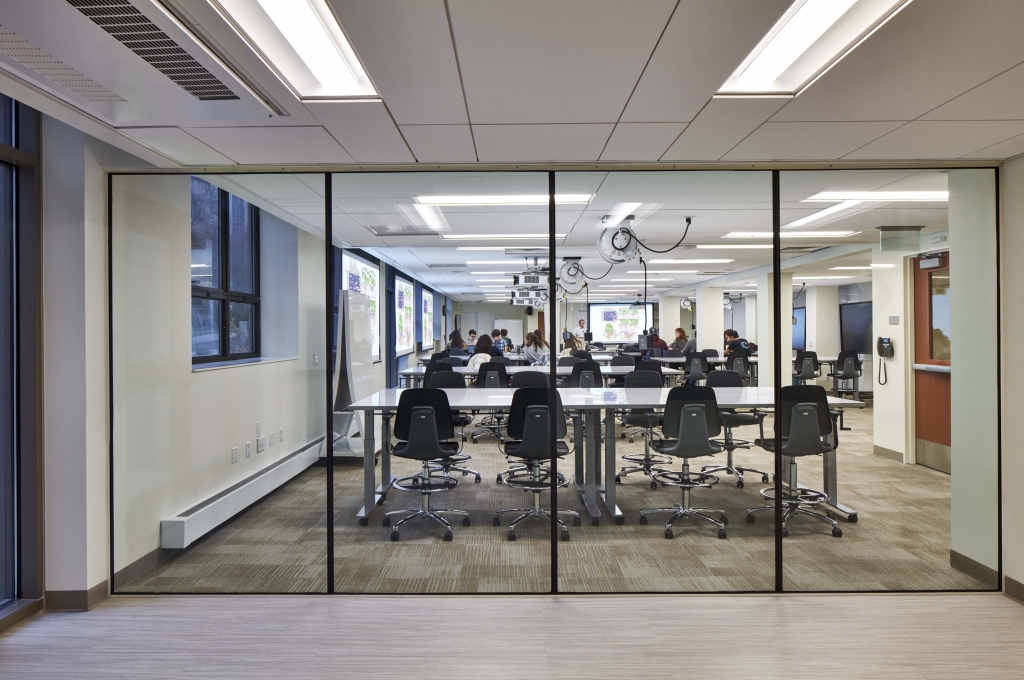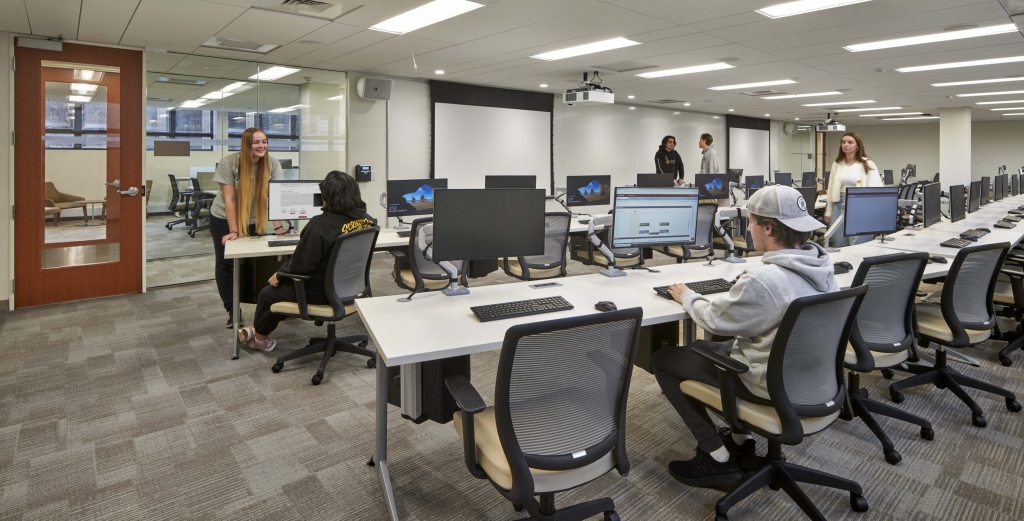Following the success of 245 Beacon at Boston College, PAYETTE continued to the renovation of the adjacent Service Building to accommodate the growing Human Centered Engineering program and Schiller Institute, both of which have a home base at 245 Beacon.
Originally built in 1947, the Service Building housed the campus boilers and high voltage power hub for decades. Over the years it has undergone two major expansions, the first being in 1985 which added a top floor to the west wing and a new glazed entry with an elevator tower, then another in 2019 which expanded the boiler room and relocated the masonry chimney.
Now, this recent renovation is another significant milestone in the Service Building’s history, converting the mostly utilitarian spaces to accommodate student learning and research. It provides an overhaul of the interior spaces across two main levels of the building as well as minor upgrades to exterior space and landscaping. These new spaces are an extension to that of 245 Beacon and sought to provide the same welcoming environment, emphasizing transparency, flexibility, collaboration and daylighting.
Below is a list of the learning, research and computational spaces created:

Scientific Exploration and Material Analysis – These high bay spaces, formerly used as a service garage for Facilities’ vehicles, now house two advanced engineering teaching labs. Within the spaces are flexible casework tables (some with table mounted turrets), suspended power cord reels, fume extractor arms, and an open ceiling grid system capable of supporting 1,000 lb. point load. Equipment includes fume hoods, biosafety cabinet, material testing (Instron) equipment, future wind tunnel and water flume. The Scientific Exploration space, where a garage door once was, is now an all-glass overhead door allowing for maximum daylight and visibility, while also providing the ability to open the space to the outside.

Active Learning Classroom – Interactive small group learning for Engineering, supported by multiple audiovisual screens, mobile and touch panel displays for sharing content. A glazed partition is provided between the classroom and main building entrance to invoke transparency.

Project Lab Space – Equipped with 3D printers and ceiling mounted power reels, it is intended for engineering students to work on individual or group projects. This space can be combined with the Active Learning Classroom by opening a movable partition wall that acoustically separates the two rooms. The panels of the movable partition are faced in markerboards on both sides and can be locked in any location along the track. Whether they are grouped, paired or left individually, they act as great opportunities for collaboration.

Digital Experience – A Computer intensive classroom for advanced software learning. This space is accompanied by a VR room directly adjacent to it for students to test their work.
Schiller Institute Computational Research Space – Research space for two computational groups working on intense data analysis related to climate. It is set up like a suite, giving graduate students their own workstation along with a data visualization area to review and share work, huddle rooms for team meetings (local and abroad) and a kitchenette.
The intense existing MEP conditions and what was required to support the new spaces, as well of the limited structural capacity for new equipment, required careful planning and coordination with our engineering team, while making the best use of the available space and existing windows.
Outdoor spaces were also upgraded with new accessible paths and landscape to provide an inviting environment for the campus community.
Existing structures always provide a wide variety of challenges for designers, but it also provides the opportunity to create unique and bespoke spaces. Through all the challenges that were presented over the course of the project, the end result was a success. This was in part due to a great collaboration among the Owner, users, design and construction teams, which required quick thinking and good problem-solving skills.

